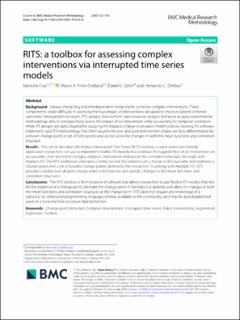| dc.contributor.author | Cruz, Maricela | |
| dc.contributor.author | Pinto-Orellana, Marco Antonio | |
| dc.contributor.author | Gillen, Daniel L. | |
| dc.contributor.author | Ombao, Hernando C. | |
| dc.date.accessioned | 2022-08-02T07:32:20Z | |
| dc.date.available | 2022-08-02T07:32:20Z | |
| dc.date.created | 2022-02-09T16:05:50Z | |
| dc.date.issued | 2021-07-08 | |
| dc.identifier.citation | BMC Medical Research Methodology. 2021, 21 (1), . | en_US |
| dc.identifier.issn | 1471-2288 | |
| dc.identifier.uri | https://hdl.handle.net/11250/3009697 | |
| dc.description.abstract | Background: Various interacting and interdependent components comprise complex interventions. These components create difficulty in assessing the true impact of interventions designed to improve patient-centered outcomes. Interrupted time series (ITS) designs borrow from case-crossover designs and serve as quasi-experimental methodology able to retrospectively assess the impact of an intervention while accounting for temporal correlation. While ITS designs are aptly situated for studying the impacts of large-scale public health policies, existing ITS software implement rigid ITS methodology that often assume the pre- and post-intervention phases are fully differentiated (by a known change-point or set of time points) and do not allow for changes in both the mean functions and correlation structure. Results: This article describes the Robust Interrupted Time Series (RITS) toolbox, a stand-alone user-friendly application researchers can use to implement flexible ITS models that estimate the lagged effect of an intervention on an outcome, level and trend changes, and post-intervention changes in the correlation structure, for single and multiple ITS. The RITS toolbox incorporates a formal test for the existence of a change in the outcome and estimates a change-point over a set of possible change-points defined by the researcher. In settings with multiple ITS, RITS provides a global over-all units change-point and allows for unit-specific changes in the mean functions and correlation structures. Conclusions: The RITS toolbox is the first piece of software that allows researchers to use flexible ITS models that test for the existence of a change-point, estimate the change-point (if estimation is desired), and allow for changes in both the mean functions and correlation structures at the change point. RITS does not require any knowledge of a statistical (or otherwise) programming language, is freely available to the community, and may be downloaded and used on a local machine to ensure data protection. Keywords: Change-point detection, Complex interventions, Interrupted time series, Policy interventions, Segmented regression, Toolbox | en_US |
| dc.description.sponsorship | This work was supported in part by KAUST research grant to the KAUST Biostatistics research group, the National Institute on Aging of the National Institutes of Health under award numbers R01AG053555 and P50AG16573, and the National Institute of Mental Health of the National Institutes of Health under award number R01MH115697. The content is solely the responsibility of the authors and does not necessarily represent the official views of the National Institutes of Health. | en_US |
| dc.language.iso | eng | en_US |
| dc.publisher | BMC | en_US |
| dc.relation.ispartofseries | BMC Medical Research Methodology;21, Article number: 143 (2021) | |
| dc.rights | Navngivelse 4.0 Internasjonal | * |
| dc.rights.uri | http://creativecommons.org/licenses/by/4.0/deed.no | * |
| dc.subject | Change-point detection | en_US |
| dc.subject | Complex interventions | en_US |
| dc.subject | Interrupted time series | en_US |
| dc.subject | Policy interventions | en_US |
| dc.subject | Segmented regression | en_US |
| dc.subject | Toolbox | en_US |
| dc.title | RITS: a toolbox for assessing complex interventions via interrupted time series models | en_US |
| dc.type | Peer reviewed | en_US |
| dc.type | Journal article | en_US |
| dc.description.version | publishedVersion | en_US |
| dc.rights.holder | © The Author(s). 2021 | en_US |
| dc.source.articlenumber | 143 | en_US |
| cristin.ispublished | true | |
| cristin.fulltext | original | |
| cristin.qualitycode | 1 | |
| dc.identifier.doi | https://doi.org/10.1186/s12874-021-01322-w | |
| dc.identifier.cristin | 1999648 | |
| dc.source.journal | BMC Medical Research Methodology | en_US |
| dc.source.volume | 21 | en_US |
| dc.source.issue | 1 | en_US |
| dc.source.pagenumber | 15 | en_US |
| dc.relation.project | National Institutes of Health: R01AG053555 | en_US |
| dc.relation.project | National Institutes of Health: P50AG16573 | en_US |
| dc.relation.project | National Institutes of Health: R01MH115697 | en_US |

